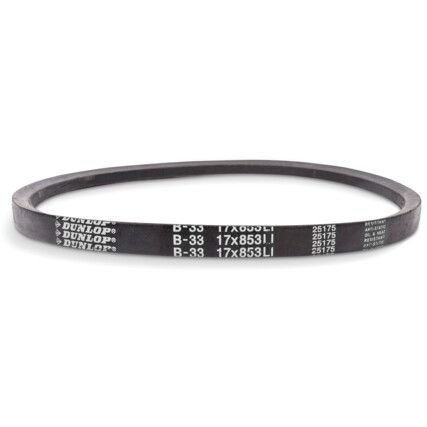V Belts
Sometimes referred to as a wedge or drive belt, V belts play a crucial role in the transfer of power between parallel shafts. Used widely in industrial machinery and agricultural equipment, they deliver excellent heat and oil resistance for improved operational capabilities.
Find high-quality V belts at Cromwell from reliable brands like Dunlop BTL® and Continental Contitech®.
What are V belts?
Usually made of rubber or synthetic material, V belts feature load-bearing cords embedded into the main body of the belt, which is connected at the end to make a loop. The belts are tightly loaded into the groove of a pulley system where the cross-section of a V belt, once properly fitted resembles a 'V' with the tapered sides forming a wedge in the pulley. Once turned on, the friction created from the wedge-like fit transmits power between the belt and pulleys.
Why V belts?
V belts are extremely easy to fit and are reliable to start and run. They don't need lubrication to work, which reduces maintenance and checking times.
When are V belts used?
V belts are used in a wide range of industries and make an appearance in domestic appliances, car engines and industrial machinery to name but a few.
V belt types
There are 6 types of V belts on the market available in different sizes to suit various types of pulley systems and applications.
• Conventional V belts - The most commonly used, they're sized using letters A-E with a 40° tapered angle.
• Narrow V belts - Smaller than conventional belts, but with a similar load-bearing capacity.
• Cogged/notched V belts - Suitable for tight bends and turns around smaller pulleys.
• Link V belts - Made up of a series of links, a worn or broken link can be replaced as required and reduced to fit a pulley system.
• Banded V belts - Two individual belts connected with a layer of rubber and fabric to stabilise the belt and keep it working effectively.
• Ribbed V belts - Are extremely strong due to the extra tension required to run them. They must be used in conjunction with a matching ribbed pulley system to ensure proper alignment.
Considerations when choosing a V belt
• Application - the conditions in which the V-belt is to operate, including operating speeds, extreme temperatures and exposure to oil-based liquids should be considered when deciding on a light or heavy-duty belt.
• Profile - available in different types and measurements, cogged and ribbed V-belts often need to be fitted to matching pulleys to ensure the correct alignment.
• Length - be aware that V belts can stretch slightly over time, so if you're replacing one choose the smaller size just to be safe.
V belt jargon buster
To make it easier to find the V belt you need, we've explained a V belt standard that is frequently found on technical datasheets.
What does standard ISO 4184:1992 mean?
ISO 4184:1992 lays out the recommended lengths and tolerances for V belts. Published in 1992 and corrected in 1993, this edition replaced the 1980 original standard.
Let's break it down...
• ISO - The International Standard Organisation prepare and publish safety and quality standards
• 4184 - This is the legislation number
• 1992 - This is the date the second edition was published
FAQs
How do I measure a V belt?
In millimetres, measure the surface width of the belt, and then the depth. Make a visible mark on the belt to act as a starting point and wrap a piece of string around the belt to where the ends meet this point. Then measure the string against the tape measure to get your total measurements.
How do v belts work?
V-belts are wedged into a pulley system with the tapered edges aligning with the pulley system sheaves. Once engaged and moving, the wedge-like fit creates friction and transmits power between the parallel shafts.

